

How Can Educators Deliver Equity in a Digital Environment? (Webinar Recap) Learn an equity framework to help you deliver quality to all learners, within a digital environment or a broader context, then explore some features in the Kiddom + Open Up Resources distance learning bundle that can help you implement equitable practices in your digital or blended classroom.
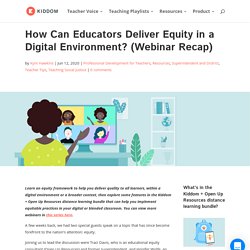
You can view more webinars in this series here. A few weeks back, we had two special guests speak on a topic that has since become forefront to the nation’s attention: equity. Joining us to lead the discussion were Traci Davis, who is an educational equity consultant (Open Up Resources) and former superintendent, and Jennifer Wolfe, an education advisor (Kiddom) and early advocate of open education resources. As part of this ongoing distance learning webinar series, the focus of our discussion was equity within the context of remote learning. Black lives matter from hashtag to movement. Making Anti-Racism a Priority (Lessons from My Former Principal) - westphma - Wauwatosa School District Mail. Lesson of the Day: ‘“I Can’t Breathe”: 4 Minneapolis Officers Fired After Black Man Dies in Custody’ CNVS 02_NYT Final Script_150429 Transcript Start time: 00:00:00 Rakesh: Racism means basically like...
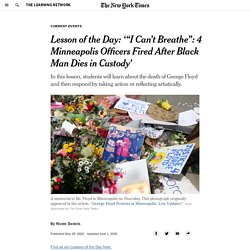
Miles: A large, a large part of uh...a race feels that they’re superior to another race and so and so not only do they believe that but they act on it. Malik: Examples would be in class sometimes I’d be the only black kids and we’d read a book like, I don’t know, Huck Finn and then there’s that uncomfortable moment...the “magic” word would come up and people look at you like “What’s his reaction?” Teaching Ideas and Resources to Help Students Make Sense of the George Floyd Protests. Updated, June 8 “The anger is different this time.

After years of Americans being killed by the police — more than 1,000 per year, for as long as statistics exist — something has changed over the past week,” begins the June 2 “Morning” newsletter. It continues: The gruesome video of a Minneapolis police officer kneeling on George Floyd’s neck plays a role. So does a pandemic that’s disproportionately killing African-Americans. Teachers know that this news and the issues around it need to be addressed. Talking About Race.
An Unconventional Approach to Culturally Responsive Pedagogy. When I started working as a Spanish teacher at Bellaire High School in Houston, Texas, in 2018, I was immediately immersed in the diverse cultures of a large, urban, Title I public school.
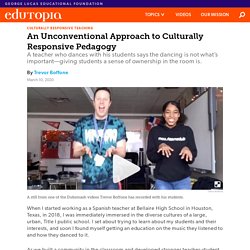
I set about trying to learn about my students and their interests, and soon I found myself getting an education on the music they listened to and how they danced to it. As we built a community in the classroom and developed stronger teacher-student bonds, we started making Dubsmash dance videos on Fridays when my students finished their work for the week. Twin Teens: One Black, One White, Celebrate Their Differences. Black History Month: How do we change history? To the teacher: February is Black History Month, a time when teachers around the country seek out materials and initiate projects that acknowledge and celebrate African American contributions to our society.
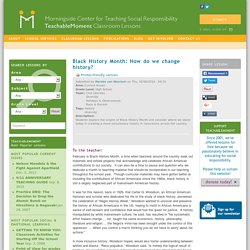
It can also be a time to pause and question why we dedicate a month to teaching material that should be incorporated in our teaching throughout the school year. Though curricular materials may have gotten better at including the contributions of African Americans since the 1960s, black history is still a largely neglected part of mainstream American history. It was for this reason, back in 1926, that Carter G. Woodson, an African American historian and scholar who dedicated his life to the study of black history, pioneered the celebration of “Negro History Week.”
Gathering Ask student if they know what the month February has been designated to celebrate. Check Agenda and Goals. Black History Month & the Danger of a Single Story. Preparation To prepare for this lesson: Make copies for students of this handout about Black History Month Make copies for students of this handout with quotes Preview and prepare for students to view this 19-minute TED Talk Assign students the homework assignment below in advance of the lesson Homework Assignment For homework, invite students to bring an item from home that represents who they are, an item that tells a key story about them and how they see themselves.
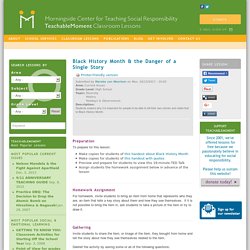
If it is not possible to bring the item in, ask students to take a picture of the item or try to draw it. Gathering Invite students to share the item, or image of the item, they brought from home and tell the story about how they see themselves related to the item. Share any connections, reflections or additions you have based on the stories you just heard.
Check Agenda and Objectives. 11 Things White People Should Never Say to Black People. Black History Month is a U.S. observance that was first introduced in 1926 as “Negro History Week,” eventually becoming a month-long affair in 1976.
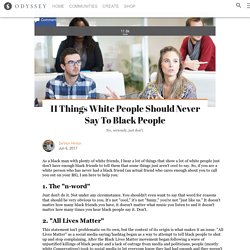
While this may have been a well-intentioned attempt to integrate lesser-known history pertaining to black people into our overall teaching in society and in schools, it has been a point of contention since it began. Now more than ever, though, Black History Month does more harm than good. Black History Month #1 - What is Black History Month? Common - Black America Again ft. Stevie Wonder. Teaching Tolerance - Diversity, Equity and Justice. Objectives: Activities will help students: Explain how music evokes feelings and emotion.Understand relationships between music and culture.Analyze song lyrics to critically examine themes and messages.Consider the effectiveness of music to communicate ideas.Use music to express a personal viewpoint or message about a tolerance-related issue that’s important to them.
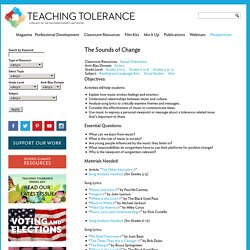
Essential Questions: Being 12: 'People Think I'm Supposed to Talk Ghetto, Whatever That Is.' Racism is a 'big problem' to more Americans, poll finds. Alex Sproul reads about it in his Facebook feed.
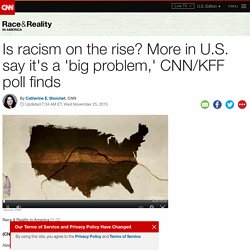
Sheryl Sims senses it when she walks down the street. They are three Americans from three different demographic groups living in three different states. And they believe the same thing: Racism is a big problem. RACE - The Power of an Illusion . Sorting People. The Brutality of a Country. I Am NOT A Label.
A Conversation on Race. Assignments. Mary's Text Set - 2016.02.15. Human Variation. History of the Civil Rights Movement. Hate Map. The Changing Face of America. What is it about the faces on these pages that we find so intriguing?
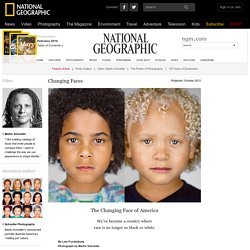
Is it simply that their features disrupt our expectations, that we’re not used to seeing those eyes with that hair, that nose above those lips? Our responses can range from the armchair anthropologist’s benign desire to unravel ancestries and find common ground to active revulsion at group boundaries being violated or, in the language of racist days past, “watered down.” Out in the world, the more curious (or less polite) among us might approach, asking, “Where are you from?” Or “What are you?” We look and wonder because what we see—and our curiosity—speaks volumes about our country’s past, its present, and the promise and peril of its future.
The U.S. The Census Bureau is aware that its racial categories are flawed instruments, disavowing any intention “to define race biologically, anthropologically, or genetically.” Sandra Williams, 46, grew up at a time when the nation still turned on a black-white axis. For Kids. 21 Things You Can't Do While Black. iStock Update: On October 17, 2014, Michael Dunn was sentenced to life in prison without the possibility of parole for the murder of Jordan Davis. Update: On February 15, 2014, the judge in the murder trial of Michael Dunn declared a mistrial on the first-degree murder count after the jury could not come to a decision. The jury reached verdicts for the other charges Dunn faced, and he was found guilty of three counts of attempted second-degree murder and one count of throwing a deadly missile. RACE - The Power of an Illusion. @TheSocyCinema - Home. The Changing Face of America - Photo Gallery. Full List of Stuff White People Like.